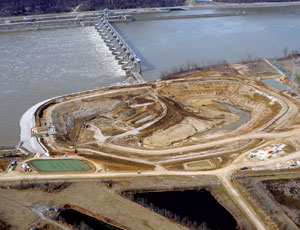The growing demand for renewable energy has pushed one big Ohio power provider to build five hydroelectric projects, worth $2 billion, on existing Ohio River valley dams.

American Municipal Power (AMP) Inc., Columbus, says that, when finished in five years, the projects will produce more than 350 MW of electricity, enough to serve more than 250,000 households, with minimal environmental impact. The non-profit firm secures and sells power to publicly owned utilities in six states along the river. Project supporters say it could help reduce annual carbon-dioxide emissions by 2 million metric tons.
“We’ve been doing so much hydro work in Canada, it’s exciting for us to see the American market opening back up,” says Kent Grisham, a spokesman for Kiewit Corp., Omaha, which is completing the excavation and cofferdam for AMP’s first project at the Cannelton Locks and Dam near Hawesville, Ky., with Traylor Bros. Inc., Evansville, Ind.
The U.S. Energy Dept. and the National Hydropower Association have long touted adding powerhouses to existing dams to produce electricity. DOE says there is more than 15,000 MW of potential power for larger hydro projects on existing dams and 60,000 MW of potential power on smaller dams.
The AMP projects will place powerhouses adjacent to or attached to five concrete dams built by the Army Corps of Engineers in the late 1960s and 1970s. The Corps designed the dams for powerhouse retrofits, says Phil Meier, AMP assistant vice president of hydroelectric development. The setup uses the dams’ existing head and flow rate to produce electricity without changing the Ohio’s overall flow. The power counts as renewable electricity in states along the river with renewable portfolio standards.
John Seebach, director of the hydropower reform initiative for the environmental group American Rivers, says the projects are not technically “run-of-river,” which would produce electricity from water flow without an impoundment. But they are best way to produce hydroelectricity, he says. American Rivers has been working with the association to secure federal incentives for powerhouse retrofits, he says.
Meier says AMP selected the five sites after analyzing 10 possible locations along the Ohio River. Two of the five were previously licensed by the Federal Energy Regulatory Commission in the late 1980s. AMP is looking to increase its production capacity after it canceled construction of a 1,000-MW coal plant in Ohio late last year, and the company may boost its Ohio River hydro capacity further, Meier says.
The Cannelton project is set to come online in 2013. The Kiewit-Traylor team is finishing construction of the 1,353-ft-x-890-ft site cofferdam, and on May 21, AMP will open bids to build the powerhouse that will hold three turbines.
This month, C.J. Mahan Construction Co., Grove City, Ohio, will begin cofferdam excavation and construction at the Smithland, Ky., project site, and later this year, Ruhlin Co., Sharon Center, Ohio, will start on the Willow Island locks-and-dam site in Newport, Ohio. AMP is in final negotiations with Angelo Iafrate Construction, Warren, Mich., for cofferdam excavation and construction at the Meldahl locks-and-dam site in Felicity, Ohio. A fifth project, the Robert C. Byrd locks-and-dam site in Gallipolis Ferry, W.Va., awaits FERC approval. MWH Americas Inc., Broomfield, Colo., is the owners’ engineer for all the projects.
Voith Hydro, York, Pa., has a $423- million contract with AMP to build the 11 turbines for the five projects. The company, which says the contract is the largest in its 131-year history, will manufacture the turbines at a former Ormet Rolling Mill in Hannibal, Ohio.
The projects are being financed through AMP-issued bonds.

Post a comment to this article
Report Abusive Comment